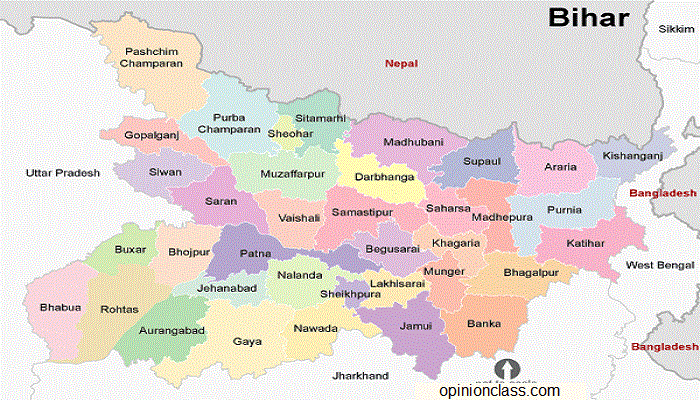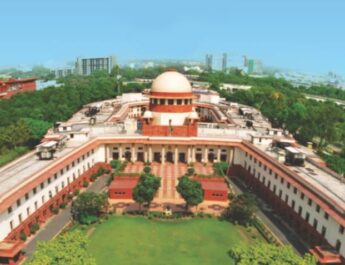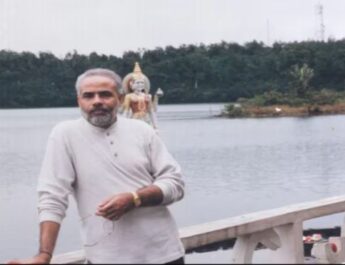Bihar is located in the eastern part of India and is surrounded by the Nepal in north, West Bengal in the east, Uttar Pradesh in the west and Jharkhand in the south. With the population of 103,804,637, Bihar is one of India’s poorest states and has acquired an area of 38,301 square miles (99,200 square km). Patna is the capital of Bihar.
Bihar consists of three distinct regions Magadh, Mithila and Bhojpur, each has its own history and culture. These regions are mentioned in religious texts and epics of ancient India.
The word Bihar is derived from the Sanskrit word Vihara which means resting house of Buddhist monk but it was the Muslim rulers of 12th Century who started calling the state as Bihar.
Bihar has become the founder of many great empires like Magadh, Nanda, Maurya and Gupta. However, these empires had made Pataliputra (modern-day Patna) their capitals. Two of India’s major religions also have their roots in Bihar. Gautama Buddha, the founder of Buddhism, had achieved enlightenment in Bihar’s Bodh Gaya, while Mahavira, the founder of Jainism, was also born in Vaishali in North Bihar.
For centuries, Bihar was the symbol of Indian culture and civilization. During early Vedic period, several kingdoms were existed on the soil of Bihar. North of the Ganges was Videha, one of the kings and the father of princess Sita, the wife of Lord Rama and the heroine of the Ramayana. During the same period, Rajagriha (now Rajgir) had decided as the capital of the Magadha kingdom.
Bihar and Orissa, the two divisions of the Bengal Presidency, was ruled by Britishers until 1912. On March 22, 1912, both Bihar and Orissa divisions were separated from the Bengal Presidency. On April 1, 1936, the province was partitioned into Bihar and the Orissa povinces.
Later, Bihar has played an important role in the Indian Mutiny of 1857. The Father Of Nation Mohandas Karamchand Gandhi aka Mahatma Gandhi, who advocated the philosophy of nonviolence, had first started the satyagraha against the tyranny of the European indigo planters in the Champaran region of northern Bihar.
Upon India’s independence in 1947, Bihar became a state in 1950. A territory of some 3,140 square miles (8,130 square km) was transferred from Bihar to West Bengal after the reorganization of state on linguistic basis in 1956.
Population
Bihar, India’s third largest populous state after Uttar pradesh and Maharastra, has population of 10.41 Crores, an increase from figure of 8.30 Crore in 2001 census. As per the 2011 census, Bihar has population of 104,099,452 of which male and female are 54,278,157 and 49,821,295 respectively.
In 2001, total population was 82,998,509 in which males were 43,243,795 while females were 39,754,714. Increased from 106,115 in 2012 to 123,083 in 2021, Bihar has been growing at an average annual rate of 1.66%.
With 82.6%, Hinduism is the major religion Bihar while the state accounts for 16.87% of Muslim population, and other religions like Buddhism, Christian, Sikh and Jain accounts for less than 1%, the 2011 census estimated.
As per the raw estimate of castes, around 5.7% are Brahmins, 4.7% are Bhumihar, 5.2% are Rajputs, 14.4% are Yadav, 4% are Kurmi, 8% are Kushwaha, 17% are Muslims, 2% are Kayastha, 6% are Baniya, 3% are Teli, 2% are Mushahar and 4% are Dusadh in Bihar.
Economy
Bihar, an underdeveloped and poor state with low per captia income, is vastly dependent on agriculture and around 80% of state population is employed in agricultural activities. It is the fourth largest producer of vegetables and the 8th largest producer of fruits in India. Food processing, dairy, sugar, manufacturing, and healthcare are some of the fast-growing industries of Bihar.
Despite significant gains in mining and manufacturing in the late 20th century, Bihar has continued to lag behind other Indian states in per capita income. However, a large segment of the population remains below poverty level. At the turn of the 21st century the creation of the state of Jharkhand from Bihar’s southern region further strained Bihar’s struggling economy.
Language
Hindi is widely spoken language in Bihar with 77% speakers, followed by Maithili with 12.54% and Urdu with 8.4%. Hindi is the official language that every Bihari speaks even if he or she is Maithili and Urdu speakers.
Bhojpuri, Angika and Magahi are widely spoken in some parts of Bihar and is considered one of the Hindi dialects. The Other languages like Bengali, Punjabi, Gujarati are the migrated people representing less than 1% each. Maithili is most widely spoken language in Bihar.
Rivers
The total geographical area of Bihar is about 94000 Sq Km, out of which about 54000 Square Kilometre belongs to North-Bihar and remaining 40000 Sq Km belongs to South Bihar. Both the two parts of Bihar is divided by the ganga river, which passes through almost middle of Bihar. Besides the Ganga, many other rivers are also flow in both parts of the state.
However, the Northern Bihar rivers are perennial (flows all year) while rivers in South Bihar are non-perennial (flows during rainy season mainly and remain almost dry in summer season).
Major rivers of Bihar are as follows
Ganga: The river enters into Bihar from Chausa. Bagmati, Kosi, Gandak, Sone, Punpun are the important tributaries of the Ganga river.
Gandak: This river flows in a southern direction.
Bagmati: The river riginates from Nepal and flows through Bihar and meets finally Ganga. The river flows from Darbhanga, Muzaffarpur, and Samastipur.
Mahananda: Ratwa, Balason and Kankai are the main tributaries of Mahananda.
Kosi: Kosi is also known as Sorrow of Bihar.
Kamla: Originates from Nepal and flows through Bihar. Soni, Dhauri, Balan and Trisula are the main tributaries of Kamla.
Transportation
Bihar enjoys transportation facilities with vast network of roadways, railways and airways that connects the state with other major parts of the country. The state provides convenient and cost-effective transportation with 5,358 km (3,329 miles) long national highways and 4,006 km (2,489 mi) state highway.
Road: The NH 30 and 31 connects, Gangtok, Varanasi, Lucknow, New Delhi and Calcutta.
Air: Air services connect Patna with Calcutta Ranchi, Lucknow, Kanpur, Delhi, Guwahati, Ahmedabad, Allahabad and Kathmandu.Vayudoot connects Patna with Jamshedpur, Gaya, Dhanbad and Calcutta.
Rail: The railwau route of the state is well connected with India’s major city of Calcutta, Delhi, Ranchi, Rajgir, Bombay, Varanasi, Jammu, Guwahati, amongst other places. In 1864, the state had started the rail line between Kolkata (Calcutta) and Delhi, which crosses Bihar.
BSRTC, started in 1953 as a state-run transport service provider, provides transportation between Bihar and Jharkhand. On average, more than 3 to 5 lakhs people have used public transport system to travel across the state.
Tourism
Bihar is enriched with heritage sites of various religions including temples, stupas, masjids, tombs and various dynasties and cities. The historical importance of Bihar was established with the discovery of the biggest ever Buddhist stupa at Kesariya.
As per the Archeological Survey of India (ASI), the state’s most important religious and heritage sites are Bodhgya, Rajgir, Nalanda, Vaishali, Valmikinagar, Maner sharif and Motihari etc.
The state was rich in its wildlife as the neighboring states of Orissa and Madhya Pradesh but the changes relating to destruction of Habitat and poaching are the most serious factors leading to the depletion of wildlife.
Education
Historically, Bihar has been a major learning centre of India as the state had ancient universities Nalanda (est. 450 CE), Odantapurā (est. 550 CE) and Vikramashila (est. 783 CE).
The 2011 census estimated that the Bihar has an overall literacy rate of 61.35 % . In terms of gender, the 60.32% male of the state are literate while the literacy rate of females stands at 33.57%. As per the state government figures, Bihar has 72,663 government schools, including 42,573 primary, 25,587 upper primary, 2,286 secondary and 2,217 senior secondary schools.
As per the NITI Ayog data, Bihar has witnessed a slight improvement of 7.3% in 2016-17 in the overall performance when compared with 30% in 2015-16. The NITI Ayog report also claimed that Bihar has achieved 99.6% in elementary education and 54.5% in secondary level in 2016-17. Around 35.9% children are still out of school in Bihar when compared with 50.3% in 2015-16, the report said.
Also, as per the survey of All India Survey of Higher Education (AISHE), Bihar has recorded the lowest gender proportion where female to male teachers’ ratio is 1:4 which is in percentage terms 75.3% for male and only 24.7% for female teachers.
The state has 209 IAS officers and 219 IPS officers, besides thousands of class-I and II officers. According to official figures, Bihar has 72,663 government schools, including 42,573 primary, 25,587 upper primary, 2,286 secondary and 2,217 senior secondary schools.




